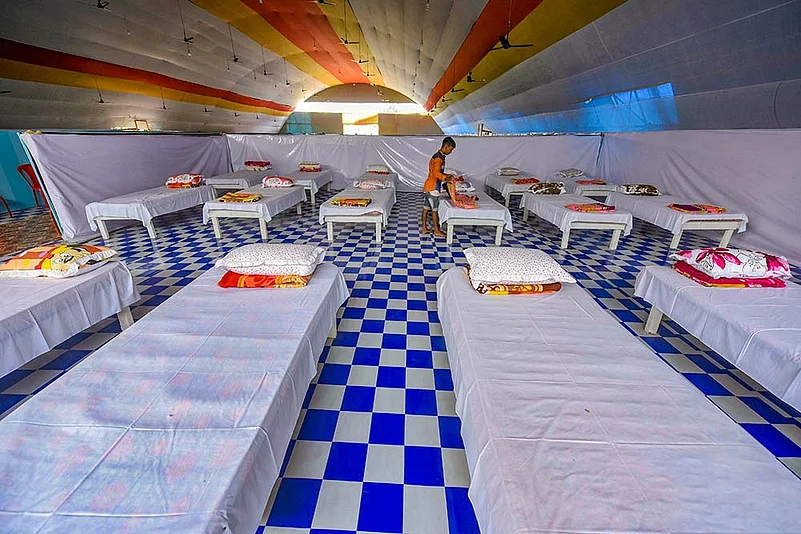Looking at the increasing numbers of COVID-19 cases in India and the declining recovery rate, there is an urgent need for temporary COVID-19 recovery facilities with ICUs to boost the current capacity of hospitals. Given the tall task, it is an opportunity for innovative, solution-oriented educational institutions to come forward and present scalable, out-of-the-box solutions.
Being a design university, this is exactly what Anant National University, Ahmedabad, has done. We deployed design thinking and devised a solution to the challenge of a shortage of space to treat or isolate the rising number of COVID-19 patients.
First, let us briefly look at the number of hospital beds available per person across the country. According to the National Health Profile, 2019, there are only 0.11 government hospital beds per 1,000 people in Bihar. States such as Jharkhand, Uttar Pradesh, Madhya Pradesh, Odisha, Assam, Manipur and Maharashtra are also below the national average of 0.55 government beds per 1,000 people. Moreover, only 5 to 8 per cent of these are ICU beds.
Advertisement
Further, the absence of a vaccine for Coronavirus implies that in future, we will continue to have COVID-19 cases, with the number spiking at times like these. As hospitals will soon have to cater to patients of other ailments as well, we need a system in place to exclusively quarantine COVID-19 patients.
Moreover, once India is better equipped to test for COVID-19, there will be more number of asymptomatic and mildly symptomatic patients, who will need to be immediately quarantined to contain the spread.
For the above-stated reasons, we need several thousand COVID-19 recovery facilities that can be set up quickly, affordably, scaled up, and later dismantled. These are needed more so in slum areas where social distancing is impossible, as well as rural and urban districts with no hospitals and healthcare centres.
Advertisement
As per the Census of 2011, there are a total of 33,08,35,767 houses in India, of which, about 7.5 per cent (2,48,12,682) are vacant. 95 per cent of these vacant houses are in a liveable condition. Community halls, marriage halls and auditoriums will also be vacant during the spread of the pandemic. Cities like Mumbai have a surplus supply of office buildings that are vacant. All this amounts to a massive number of vacant infrastructures, readily available across all Indian states, which must be used immediately to host the rapidly increasing COVID-19 patients.
We at Anant National University (AnantU) have leveraged our faculty members, who are some of India’s leading architects, planners and real estate developers, to propose a solution to rapidly scale up COVID-19 recovery facilities by utilising existing hard infrastructures and refurbishing them to provide COVID-19 recovery facilities with 10 per cent ICU beds. The facility would cater to all categories of COVID-19 patients – from moderate to severe symptoms of coronavirus. Our team has already identified equipment suppliers and funding structure and layouts are ready to implement this plan immediately.
We have prioritised the conversion of halls as ventilators, as oxygen and monitoring systems for ICUs are easier to set up here. Government-owned halls and residential buildings will be relatively straight forward to acquire for this purpose. Some of these halls can continue to be COVID-19 recovery facilities for as long as the pandemic exists, while others can be dismantled once the curve ebbs.
Private developers and owners of vacant office spaces and residential buildings can be incentivised. MCA has already announced that funds spent on measures to tackle the Coronavirus outbreak will be counted as Corporate Social Responsibility (CSR) activity of companies. However, as per law, if a company is in losses in any 3 preceding years, it is exempt from spending money on CSR, and there is a high likelihood that several private entities might incur a financial loss for 2019-2020. The CSR route also does not offer any incentive to a company with less than Rs 500 crore net worth – the minimum requirement which makes CSR legally compulsory for a company.
Advertisement
We thus propose a PPP model that can compensate private owners/developers of community and marriage halls by offering them free Ticket Deposit Receipt (TDR) for their next project (with a cap equalling the TDR value of the current building used for COVID-19 facility). A faster mechanism is also proposed to give a GST credit equivalent to the space offered as COVID-19 facility.
Anant National University has submitted this plan to the Prime Minister’s Office and is collaborating with Parliamentarians with Innovators for India (PII) to implement this plan. Dr Miniya Chatterji, who is leading the initiative at AnantU, is also a Mentor at PII and is instrumental in establishing this collaborative implementation. The implementation will start with Kerala and then rapidly progress to other parts of the country, where health care is difficult to access.
Advertisement
Some ad-hoc spaces, including parking lots, schools, and railway compartments are already being converted into COVID-19 recovery facilities, but we definitely need a more organised, affordable and scalable plug-and-play model to benefit the country on a large scale.
(Dr. Anunaya Chaubey is the Provost at Anant National University. Views expressed are personal)




















